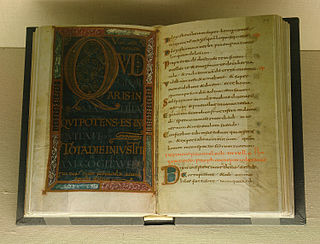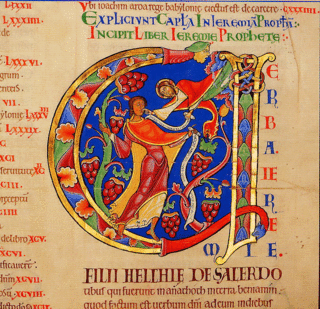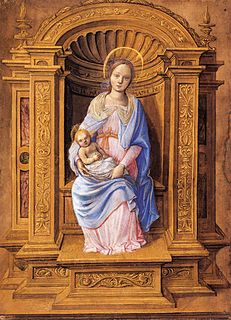
The Skara Missal is a 12th-century illuminated manuscript, a missal kept in Stifts- och landsbiblioteket i Skara, a library in Skara, Sweden. [1] It is the oldest surviving missal of this kind in Scandinavia. [2] It is written in Latin, [1] and is in folio format. [3] Only about one eighth of the original remains, [4] or 44 pages. [3] The book was originally bound in a single volume, but is since the 13th or 14th century split into two volumes. One of the volumes is currently part of the permanent exhibition of Västergötland Museum. It was written by two different scribes. [3] It contains text, illuminations and musical notes. [3] The illuminations consist of two full page illustrations, four large decorative initials and a number of smaller ones. Certain traits indicate that the illuminator may have come from Scandinavia. [2]

An illuminated manuscript is a manuscript in which the text is supplemented with such decoration as initials, borders (marginalia) and miniature illustrations. In the strictest definition, the term refers only to manuscripts decorated with either gold or silver; but in both common usage and modern scholarship, the term refers to any decorated or illustrated manuscript from Western traditions. Comparable Far Eastern and Mesoamerican works are described as painted. Islamic manuscripts may be referred to as illuminated, illustrated or painted, though using essentially the same techniques as Western works.

A missal is a liturgical book containing all instructions and texts necessary for the celebration of Mass throughout the year.
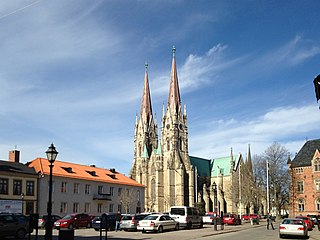
Skara is a locality and the seat of Skara Municipality, Västra Götaland County, Sweden with 18,580 inhabitants in 2013. Despite its small size, it is one of the oldest cities in Sweden, and has a long educational and ecclesiastical history. One of Sweden's oldest high schools, Katedralskolan, is situated in Skara.
Contents
The Skara Missal is sometimes referred to as "Sweden's oldest book" but its origins remain unclear. [3] It may have been made in Winchester (England), Normandy (France), or possibly Norway; it mentions the saint Swithun who was venerated in both England and Norway. [3] Studies of its contents have pointed to possible connections with other illuminated manuscripts from Fulda (Germany), Echternach (Luxembourg), Winchcombe (England) as well as French manuscripts. [2] The missal is mentioned in the catalogue of the library in Skara for the first time in 1748, [3] but according to the Skara Stiftshistoriska Sällskap (Skara Diocese Historical Society) it has belonged to the Diocese of Skara since the Middle Ages. [4]

Winchester is a city and the county town of Hampshire, England. The city lies at the heart of the wider City of Winchester, a local government district, and is located at the western end of the South Downs National Park, along the course of the River Itchen. It is situated 60 miles (97 km) south-west of London and 13.6 miles (21.9 km) from Southampton, its closest city. At the time of the 2011 Census, Winchester had a population of 45,184. The wider City of Winchester district which includes towns such as Alresford and Bishop's Waltham has a population of 116,800.

Normandy is one of the 18 regions of France, roughly referring to the historical Duchy of Normandy.

Norway, officially the Kingdom of Norway, is a Nordic country in Northwestern Europe whose territory comprises the western and northernmost portion of the Scandinavian Peninsula; the remote island of Jan Mayen and the archipelago of Svalbard are also part of the Kingdom of Norway. The Antarctic Peter I Island and the sub-Antarctic Bouvet Island are dependent territories and thus not considered part of the kingdom. Norway also lays claim to a section of Antarctica known as Queen Maud Land.
A team of researchers from the University of Lund has dated the pages of the missal to the mid-12th century, using radiocarbon dating techniques. This makes the book contemporaneous to the inauguration of Skara Cathedral. [1] The book is bound in covers made of oak wood covered with leather, [3] which in turn have been dated to 1264 using dendrochronology; the researchers' analysis also determined that the oak trees used grew in the vicinity of Skara. [1]
Radiocarbon dating is a method for determining the age of an object containing organic material by using the properties of radiocarbon, a radioactive isotope of carbon.
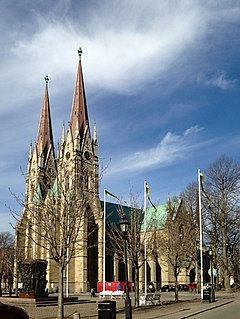
Skara Cathedral is a church in the Swedish town of Skara. The cathedral is the seat for the bishop of the Church of Sweden Diocese of Skara.
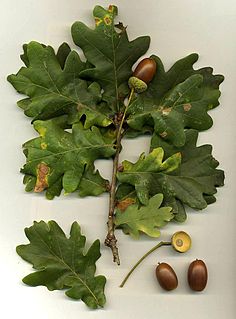
An oak is a tree or shrub in the genus Quercus of the beech family, Fagaceae. There are approximately 600 extant species of oaks. The common name "oak" also appears in the names of species in related genera, notably Lithocarpus, as well as in those of unrelated species such as Grevillea robusta and the Casuarinaceae (she-oaks). The genus Quercus is native to the Northern Hemisphere, and includes deciduous and evergreen species extending from cool temperate to tropical latitudes in the Americas, Asia, Europe, and North Africa. North America contains the largest number of oak species, with approximately 90 occurring in the United States, while Mexico has 160 species of which 109 are endemic. The second greatest center of oak diversity is China, which contains approximately 100 species.
The book has been displayed in international exhibitions, e.g. in Paris and Copenhagen, and has attracted the interest of both art historians and church historians. [3] In 2006, a facsimile edition, supplemented by a number of scholarly articles, was published. [3] [4]

Paris is the capital and most populous city of France, with an area of 105 square kilometres and an official estimated population of 2,140,526 residents as of 1 January 2019. Since the 17th century, Paris has been one of Europe's major centres of finance, commerce, fashion, science, and the arts.

Copenhagen is the capital and most populous city of Denmark. As of July 2018, the city has a population of 777,218. It forms the core of the wider urban area of Copenhagen and the Copenhagen metropolitan area. Copenhagen is situated on the eastern coast of the island of Zealand; another small portion of the city is located on Amager, and is separated from Malmö, Sweden, by the strait of Øresund. The Øresund Bridge connects the two cities by rail and road.
Church history or ecclesiastical history as an academic discipline studies the history of Christianity and the way the Christian Church has developed since its inception.
